Magnesium Promotes Growth–Metabolism Balance in Juvenile Largemouth Bass (Micropterus salmoides) and Modulates Antioxidant–Inflammatory–Apoptotic Responses Under Heat Stress
Abstract
1. Introduction
2. Materials and Methods
2.1. Experiment Diet
2.2. Fish Culture
2.3. Sample Collection
2.4. Heat Stress Trial
2.5. Laboratory Analysis
2.6. Statistical Analysis
3. Results
3.1. Growth Performance
3.2. Whole-Body Composition
3.3. Plasma Biochemical Indices
3.4. Genes Related to Glucose Metabolism in the Liver
3.5. Genes Related to Lipid Metabolism in the Liver
3.6. Genes Related to Protein Metabolism in the Liver
3.7. Plasma Antioxidant Indices Under Heat Stress
3.8. Genes Related to Immunity in the Gill Under Heat Stress
3.9. Plasma Ion Concentrations and Gill Na+/K+-ATPase Activity Under Heat Stress
3.10. Genes Related to Apoptosis and TUNEL Immunofluorescence Labeling Analysis in the Gill Under Heat Stress
4. Discussion
4.1. Effect of Mg on Growth Performance and Optimal Mg Requirement
4.2. Effect of Mg on Protein Metabolism
4.3. Effect of Mg on Glucose Metabolism
4.4. Effect of Mg on Lipid Metabolism
4.5. Effect of Mg on Plasma Antioxidant Capacity and Gill Immunity Under Heat Stress
4.6. Effect of Mg on Plasma Ion Concentrations and Gill Na+/K+-ATPase Activity Under Heat Stress
4.7. Effect of Mg on Gill Apoptosis Under Heat Stress
4.8. Limitations and Prospects
5. Conclusions
Author Contributions
Funding
Institutional Review Board Statement
Informed Consent Statement
Data Availability Statement
Conflicts of Interest
References
- David, L.H.; Pinho, S.M.; Agostinho, F.; Kimpara, J.M.; Keesman, K.J.; Garcia, F. Emergy synthesis for aquaculture: A review on its constraints and potentials. Rev. Aquac. 2020, 13, 1119–1138. [Google Scholar] [CrossRef]
- Zhang, L.; Liu, Z.; Deng, Y.; He, C.; Liu, W.; Li, X. The Benefits of Nanosized Magnesium Oxide in Fish Megalobrama amblycephala: Evidence in Growth Performance, Redox Defense, Glucose Metabolism, and Magnesium Homeostasis. Antioxidants 2023, 12, 1350. [Google Scholar] [CrossRef]
- Zhang, Y.; Fan, Z.; Wu, D.; Li, J.; Xu, Q.; Liu, H.; Wang, L. Dietary magnesium requirement on dietary minerals and physiological function of juvenile hybrid sturgeon (Acipenser schrenckii♀ x Acipenser baerii♂). Aquac. Int. 2021, 29, 1697–1709. [Google Scholar] [CrossRef]
- Han, D.; Liu, H.; Liu, M.; Xiao, X.; Zhu, X.; Yang, Y.; Xie, S. Effect of dietary magnesium supplementation on the growth performance of juvenile gibel carp, Carassius auratus gibelio. Aquac. Nutr. 2012, 18, 512–520. [Google Scholar] [CrossRef]
- Lin, Y.; Ku, C.; Shiau, S.Y. Estimation of dietary magnesium requirements of juvenile tilapia, Oreochromis niloticus x Oreochromis aureus, reared in freshwater and seawater. Aquaculture 2013, 380, 47–51. [Google Scholar] [CrossRef]
- Liu, K.; Wang, X.; Ai, Q.; Mai, K.; Zhang, W. Dietary selenium requirement for juvenile cobia, Rachycentron canadum L. Aquac. Res. 2010, 41, e594–e601. [Google Scholar] [CrossRef]
- Gupta, S.K.; Giri, S.S. Biotechnological Advances in Aquaculture Health Management; Springer: Singapore, 2021; pp. 291–312. [Google Scholar]
- Zhao, L.; Xia, Z.; Wang, F. Zebrafish in the sea of mineral (iron, zinc, and copper) metabolism. Front. Pharmacol. 2014, 5, 33. [Google Scholar] [CrossRef] [PubMed]
- Cheng, C.; Chen, S.; Huang, C. Dietary magnesium requirement of soft-shelled turtles, Pelodiscus sinensis, fed diets containing exogenous phytate. Aquaculture 2014, 432, 80–84. [Google Scholar] [CrossRef]
- de Sousa, M.S.R.; Dos Santos, L.R.; da Cunha, S.T.; Cardoso, B.E.P.; da Silva, D.T.M.; Morais, J.B.S.; de Paiva, S.M.; de Sousa, T.G.V.; da Silva, N.C.; da Silva, L.D.; et al. Participation of Magnesium in the Secretion and Signaling Pathways of Insulin: An Updated Review. Biol. Trace Elem. Res. 2022, 200, 3545–3553. [Google Scholar] [CrossRef]
- Zafar, N.; Khan, M.A. Effects of dietary magnesium supplementation on growth, feed utilization, nucleic acid ratio and antioxidant status of fingerling Heteropneustes fossilis. Anim. Feed Sci. Technol. 2021, 273, 114819. [Google Scholar] [CrossRef]
- Wei, C.; Wu, K.; Gao, Y.; Zhang, L.; Li, D.; Luo, Z. Magnesium Reduces Hepatic Lipid Accumulation in Yellow Catfish (Pelteobagrus fulvidraco) and Modulates Lipogenesis and Lipolysis via PPARA, JAK-STAT, and AMPK Pathways in Hepatocytes. J. Nutr. 2017, 147, 1070–1078. [Google Scholar] [CrossRef] [PubMed]
- Priya, A.K.; Muruganandam, M.; Sivarethinamohan, R.; Sujatha, S.; Reddy, G.M.K.; Priya, V.; Gomathi, R.; Gokulan, R.; Rao, G.T.; Kumar, M.S. Impact of climate change and anthropogenic activities on aquatic ecosystem—A review. Environ. Res. 2023, 238, 117233. [Google Scholar] [CrossRef]
- Huang, D.; Gu, J.; Xue, C.; Zhang, L.; Chen, X.; Wang, Y.; Liang, H.; Ren, M. Different Starch Sources Affect the Growth Performance and Hepatic Health Status of Largemouth Bass (Micropterus salmoides) in a High-Temperature Environment. Animals 2023, 13, 3808. [Google Scholar] [CrossRef]
- Lee, S.; Ji, K.; Choi, K. Effects of water temperature on perchlorate toxicity to the thyroid and reproductive system of Oryzias latipes. Ecotoxicol. Environ. Saf. 2014, 108, 311–317. [Google Scholar] [CrossRef]
- Bagnyukova, T.V.; Lushchak, O.V.; Storey, K.B.; Lushchak, V.I. Oxidative stress and antioxidant defense responses by goldfish tissues to acute change of temperature from 3 to 23 °C. J. Therm. Biol. 2007, 32, 227–234. [Google Scholar] [CrossRef]
- Pereira, L.A.L.; Amanajás, R.D.; de Oliveira, A.M.; da Silva, M.d.N.P.; Val Adalberto, L. Health of the Amazonian fish tambaqui (Colossoma macropomum): Effects of prolonged photoperiod and high temperature. Aquaculture 2021, 541, 736836. [Google Scholar] [CrossRef]
- Lisa, A.L.; Denise, L.B. Linking coasts and seas to address ocean deoxygenation. Nat. Clim. Chang. 2015, 5, 401–403. [Google Scholar] [CrossRef]
- Ma, S.; Lv, Y.; Hou, L.; Jia, Z.; Lin, S.; Wang, S.; He, X.; Hou, J. Effect of acute temperature stress on energy metabolism, immune performance and gut microbiome of largemouth bass (Micropterus salmoides). Aquac. Fish. 2023, 10, 260–270. [Google Scholar] [CrossRef]
- Sofia, B.; Marcia, A.S.; Sebastian, E.A.; Jaime, P.; Jorge, A.; Juan, M.E.; Veronica, B.V.; Rodrigo, Z.; Juan, A.V.; Phillip, D. High temperature induces oxidative damage, immune modulation, and atrophy in the gills and skeletal muscle of the teleost fish black cusk-eel (Genypterus maculatus). Dev. Comp. Immunol. 2025, 164, 105332. [Google Scholar] [CrossRef]
- Jia, R. Natural Antioxidants and Aquatic Animal Health. Antioxidants 2025, 14, 185. [Google Scholar] [CrossRef]
- Srinivasan, V.; Bhavan, P.S.; Rajkumar, G.; Satgurunathan, T.; Muralisankar, T. Dietary Supplementation of Magnesium Oxide (MgO) Nanoparticles for Better Survival and Growth of the Freshwater Prawn Macrobrachium rosenbergii Post-larvae. Biol. Trace Elem. Res. 2016, 177, 196–208. [Google Scholar] [CrossRef]
- Tam, M.; Gómez, S.; González-Gross, M.; Marcos, A. Possible roles of magnesium on the immune system. Eur. J. Clin. Nutr. 2003, 57, 1193–1197. [Google Scholar] [CrossRef]
- Huang, D.; Zhu, J.; Xu, G.; Zhang, L.; Chen, X.; Wang, Y.; Ren, M.; Liang, H. Sodium chloride alleviates oxidative stress and physiological responses induced by extreme winter cold in genetically improved farmed tilapia (GIFT; Oreochromis niloticus). Sci. Total Environ. 2023, 904, 166800. [Google Scholar] [CrossRef] [PubMed]
- Dolomatov, S.I.; Zukow, W.; Novikov, N.Y.; Muszkieta, R.; Bulatowicz, I.; Dzierzanowski, M.; Kazmierczak, U.; Strojek, K. The regulation of osmotic and ionic balance in fish reproduction and in the early stages of ontogeny. Russ. J. Mar. Biol. 2012, 38, 365–374. [Google Scholar] [CrossRef]
- Wendel, B.M.; Pi, H.L.; Krüger, L.; Herzberg, C.; Stülke, J.; Helmann, J.D. A Central Role for Magnesium Homeostasis during Adaptation to Osmotic Stress. Genet. Mol. Biol. 2022, 13, e0092-22. [Google Scholar] [CrossRef] [PubMed]
- Furriel, R.P.M.; McNamara, J.C.; Leone, F.A. Characterization of (Na+, K+)-ATPase in gill microsomes of the freshwater shrimp Macrobrachium olfersii. Comp. Biochem. Physiol. B-Biochem. Mol. Biol. 2000, 126, 303–315. [Google Scholar] [CrossRef]
- Gonçalves-de-Albuquerque, C.F.; Silva, A.R.; da Silva, C.I.; Castro-Faria-Neto, H.C.; Burth, P. Na/K Pump and Beyond: Na/K-ATPase as a Modulator of Apoptosis and Autophagy. Molecules 2017, 22, 578. [Google Scholar] [CrossRef]
- Sun, J.; Zhao, L.; Liao, L.; Tang, X.; Cui, C.; Liu, Q.; He, K.; Ma, J.; Jin, L.; Yan, T.; et al. Interactive effect of thermal and hypoxia on largemouth bass (Micropterus salmoides) gill and liver: Aggravation of oxidative stress, inhibition of immunity and promotion of cell apoptosis. Fish Shellfish Immunol. 2020, 98, 923–936. [Google Scholar] [CrossRef]
- Wei, S.; Jiang, W.; Wu, P.; Liu, Y.; Zeng, Y.; Jiang, J.; Kuang, S.; Tang, L.; Zhang, Y.; Zhou, X.; et al. Dietary magnesium deficiency impaired intestinal structural integrity in grass carp (Ctenopharyngodon idella). Sci. Rep. 2018, 8, 12705. [Google Scholar] [CrossRef]
- Li, M.; Du, J.; Li, S.; Zhu, T.; Lei, C.; Yan, H.; Song, H. Screening and Identification of the Biomarkers Applied for the Evaluation of Acute and Chronic Thermal Tolerance Ability in Largemouth Bass (Micropterus salmoides). Animals 2024, 14, 1435. [Google Scholar] [CrossRef]
- Shi, X.; Yuan, S.; Ma, X.; Tian, X.; Zhang, M.; Zhang, Y.; Waiho, K.; Fazhan, H.; Xu, R.; Kong, X.; et al. Analysis of relationship between growth traits and feed conversion ratio provides insights into aquaculture and breeding of largemouth bass Micropterus salmoides. Aquaculture 2024, 593, 741352. [Google Scholar] [CrossRef]
- Zhao, X.; Li, L.; Li, C.; Liu, E.; Zhu, H.; Ling, Q. Heat stress-induced endoplasmic reticulum stress promotes liver apoptosis in largemouth bass (Micropterus salmoides). Aquaculture 2022, 546, 737401. [Google Scholar] [CrossRef]
- Liang, J.; Tian, L.; Liu, Y.; Yang, H.; Liang, G. Dietary magnesium requirement and effects on growth and tissue magnesium content of juvenile grass carp (Ctenopharyngodon idella). Aquac. Nutr. 2011, 18, 56–64. [Google Scholar] [CrossRef]
- Balasubramanian, B.; Liu, W.; Sattanathan, G. Aquaculture Science and Engineering; Springer: Singapore, 2022; pp. 431–461. [Google Scholar]
- Bijvelds, M.J.C.; Flik, G.; Kolář, Z.; Kolar, Z.I.; Bonga, S.E.W. Uptake, distribution and excretion of magnesium inOreochromis mossambicus: Dependence on magnesium in diet and water. Fish Physiol. Biochem. 1996, 15, 287–298. [Google Scholar] [CrossRef]
- Wang, F.B.; Luo, L.; Lei, Q.; Li, Y.; Chen, S.; Wang, Y.G.; Wen, H.; Hu, C.J. Dietary magnesium requirements of juvenile grass carp, Ctenopharyngodon idella. Aquac. Nutr. 2011, 17, e691–e700. [Google Scholar] [CrossRef]
- Musharraf, M.; Khan, M.A. Dietary magnesium requirement for fingerlings of Rohu (Labeo rohita). Aquaculture 2018, 496, 96–104. [Google Scholar] [CrossRef]
- Lall, S.P.; Kaushik, S.J. Nutrition and Metabolism of Minerals in Fish. Animals 2021, 11, 2711. [Google Scholar] [CrossRef] [PubMed]
- Liu, C.; Wang, L.; Xu, J.; Zheng, J.; Xu, Y.; Jin, Z.; Feng, D.; Zhang, M.; Yu, M.; Jiang, H.; et al. Physiological and immune responses of largemouth bass (Micropterus salmoides) under the regulation of exercise intensity: An integrated perspective of blood, liver and intestinal analysis. Aquaculture 2024, 595, 741580. [Google Scholar] [CrossRef]
- Hu, D.; Jian, J.; Zhang, J.; Xu, X.; Wang, S.; Gong, C.; Zhang, Y.; Zhu, P.; Gu, Z.; Guan, W. Identification Of Key Genes Related to Growth of Largemouth Bass (Micropterus Salmoides) Based on Comprehensive Transcriptome Analysis. Front. Mol. Biosci. 2024, 11, 1499220. [Google Scholar] [CrossRef] [PubMed]
- Navarro-Guillén, C.; Conceiçao, L.E.C.; Pinto, W.; Siguero, I.; Urrutia, P.; Moyano, F.J.; Yúfera, M. Fast growing greater amberjack post-larvae require a high energy-high protein weaning diet. Aquaculture 2019, 499, 195–202. [Google Scholar] [CrossRef]
- Dowley, A.; Long-Smith, C.M.; Demehin, O.; Nolan, Y.; O’Connell, S.; O’Gorman, D.M. The bioaccessibility and tolerability of marine-derived sources of magnesium and calcium. Methods 2024, 226, 28–34. [Google Scholar] [CrossRef]
- Kumar, V.; Sinha, A.K.; Makkar, H.P.S.; De Boeck, G.; Becker, K. Phytate and phytase in fish nutrition. J. Anim. Physiol. Anim. Nutr. 2011, 96, 335–364. [Google Scholar] [CrossRef]
- Dabrowska, H.; Meyer-Burgdorff, K.H.; Gunther, K.D. Magnesium status in freshwater fish, common carp (Cyprinus carpio, L.) and the dietary protein-magnesium interaction. Fish Physiol. Biochem. 1991, 9, 165–172. [Google Scholar] [CrossRef]
- Yoshida, T.; Delafontaine, P. Mechanisms of IGF-1-Mediated Regulation of Skeletal Muscle Hypertrophy and Atrophy. Cells 2020, 9, 1970. [Google Scholar] [CrossRef]
- Cheng, K.; Hu, C.; Liu, Y.; Zheng, S.; Qi, X. Dietary magnesium requirement and physiological responses of marine shrimp Litopenaeus vannamei reared in low salinity water. Aquac. Nutr. 2005, 11, 385–393. [Google Scholar] [CrossRef]
- Chen, C.; Huang, C. Effects of dietary magnesium on the growth, carapace strength and tissue magnesium concentrations of soft-shelled turtle, Pelodiscus sinensis (Wiegmann). Aquac. Res. 2015, 46, 2116–2123. [Google Scholar] [CrossRef]
- Sun, B.; Chen, H.; Xue, J.; Li, P.; Fu, X. The role of GLUT2 in glucose metabolism in multiple organs and tissues. Mol. Biol. Rep. 2023, 50, 6963–6974. [Google Scholar] [CrossRef]
- Li, Y.; Li, W.; Zhu, X.; Xu, N.; Meng, Q.; Jiang, W.; Zhang, L.; Yang, M.; Xu, F.; Li, Y. VEGFB ameliorates insulin resistance in NAFLD via the PI3K/AKT signal pathway. J. Transl. Med. 2024, 22, 976. [Google Scholar] [CrossRef] [PubMed]
- Ghani, M.U.; Yang, Z.; Feng, T.; Chen, J.; Khosravi, Z.; Wu, Q.; Cui, H. Comprehensive review on glucose 6 phosphate dehydrogenase: A critical immunometabolic and redox switch in insects. Int. J. Biol. Macromol. 2024, 273, 132867. [Google Scholar] [CrossRef]
- Wang, Z.; Dong, C. Gluconeogenesis in Cancer: Function and Regulation of PEPCK, FBPase, and G6Pase. Trends Cancer 2019, 5, 30–45. [Google Scholar] [CrossRef] [PubMed]
- Luo, B.; Pan, B.; Zhao, G.; Li, J.; Sun, L. Association Between Serum Magnesium Levels and Glycemic Control in Type 2 Diabetes. Diabetes Metab. Syndr. Obes. 2024, 17, 2823–2829. [Google Scholar] [CrossRef] [PubMed]
- Azadehalsadat, D.H.; Mahtab, R.G.; Nepton, S. The therapeutic effects of magnesium in insulin secretion and insulin resistance. Adv. Biomed. Res. 2022, 11, 54–55. [Google Scholar] [CrossRef] [PubMed]
- Li, W.; Zhang, C.; Wang, J. PPARs: Modulating lipotoxicity and thus inhibiting fibrosis. Hormones 2024, 24, 85–97. [Google Scholar] [CrossRef]
- Chen, H.; Tan, H.; Wan, J.; Zeng, Y.; Wang, J.; Wang, H.; Lu, X. PPAR-γ signaling in nonalcoholic fatty liver disease: Pathogenesis and therapeutic targets. Pharmacol. Ther. 2023, 245, 108391. [Google Scholar] [CrossRef]
- Shim, K.F.; Ng, S.H. Magnesium requirement of the Guppy (Poecilia reticulata Peters). Aquaculture 1988, 73, 131–141. [Google Scholar] [CrossRef]
- Liu, X.; Ma, S.; Li, J.; Song, M.; Li, Y.; Fang, Z.; Zheng, R. Associations of Lipid Metabolites with Insulin Resistance and Hypertriglyceridemia in Youth. Clin. Transl. Metab. 2024, 22, 14. [Google Scholar] [CrossRef]
- Chen, F.; Yang, A.; Lu, Y.; Zhang, Y.; Zhang, J.; Bu, J.; Guo, R.; Han, Y.; Wu, D.; Wu, Y. Differential transport pathways of saturated and unsaturated fatty acid esters in male mouse hepatocytes. Nat. Commun. 2025, 16, 1344. [Google Scholar] [CrossRef]
- Tongyai, S.; Yves, R.; Motta, C.; Gueux, E.; Maurois, P.; Heaton, F.W. Mechanism of increased erythrocyte membrane fluidity during magnesium deficiency in weanling rats. Am. J. Physiol.-Cell Physiol. 1989, 257, C270–C276. [Google Scholar] [CrossRef]
- Chaudhary, D.P.; Boparai, R.K.; Sharma, R.; Bansal, D.D. Studies on the development of an insulin resistant rat model by chronic feeding of low magnesium high sucrose diet. Magnes. Res. 2004, 17, 293–300. [Google Scholar] [CrossRef]
- Kefaloyianni, E.; Gourgou, E.; Ferle, V.; Kotsakis, E.; Gaitanaki, C.; Beis, I. Corresponding Author Acute thermal stress and various heavy metals induce tissue-specific pro-or anti-apoptotic events via the p38-MAPK signal transduction pathway in Mytilus galloprovincialis (Lam.). J. Exp. Biol. 2005, 208, 4427–4436. [Google Scholar] [CrossRef]
- Marcelo, H.L. Oxygen in Biology and Biochemistry: Role of Free Radicals; John Wiley & Sons, Inc.: Hoboken, NJ, USA, 2004. [Google Scholar]
- Qin, J.; Mi, H.; Ren, M.; Huang, D.; Liang, H.; Zhang, L.; Teng, T.; Yin, H. A Study on the Dietary Yeast Polysaccharide Supplementation in Growth Performance, Antioxidant Capacity, and Immunity of Juvenile Largemouth Bass (Micropterus salmoides). Fishes 2025, 10, 26. [Google Scholar] [CrossRef]
- Liu, T.; Zhang, L.; Joo, D.; Sun, S. NF-κB signaling in inflammation. Signal Transduct. Target. Ther. 2017, 2, 17023. [Google Scholar] [CrossRef]
- Maier, J.A.; Castiglioni, S.; Locatelli, L.; Zocchi, M.; Mazur, A. Magnesium and inflammation: Advances and perspectives. Semin. Cell Dev. Biol. 2021, 115, 37–44. [Google Scholar] [CrossRef]
- Yang, S.; Li, D.; Feng, L.; Zhang, C.; Xi, D.; Liu, H.; Yan, C.; Xu, Z.; Zhang, Y.; Li, Y.; et al. Transcriptome analysis reveals the high temperature induced damage is a significant factor affecting the osmotic function of gill tissue in Siberian sturgeon (Acipenser baerii). Bmc Genom. 2023, 24, 2. [Google Scholar] [CrossRef]
- Robinson, J.D.; Flashner, M.S. The (Na++K+)-activated ATPase Enzymatic and transport properties. Biochim. Et Biophys. Acta 1979, 549, 145–176. [Google Scholar] [CrossRef]
- Egnew, N.; Renukdas, N.; Romano, N.; Kelly, A.M.; Lohakare, J.; Bishop, W.M.; Lochmann, R.T.; Sinha, A.K. Physio-biochemical, metabolic nitrogen excretion and ion-regulatory assessment in largemouth bass (Micropterus salmoides) following exposure to high environmental iron. Ecotoxicol. Environ. Saf. 2021, 208, 111526. [Google Scholar] [CrossRef] [PubMed]
- Alsheikh, R.; Aldulaimi, H.; Hinawi, R.; Al Sadi, F.; Al Baker, A.; Alkuwari, A.; Sameer, M.; Al Abdulla, G.; Shi, Z.; Babu, G.R. Association of serum magnesium and calcium with metabolic syndrome: A cross-sectional study from the Qatar-biobank. Nutr. Metab. 2025, 22, 8. [Google Scholar] [CrossRef] [PubMed]
- Zhao, X.; Mao, W.; Lin, Z.; Ling, Q. Heat stress induced hepatocyte apoptosis in largemouth bass Micropterus salmoides via IRE1α/TRAF2/ASK1/JNK pathway. J. Oceanol. Limnol. 2024, 42, 988–1000. [Google Scholar] [CrossRef]
- Yu, S. Na+, K+-ATPase: The new face of an old player in pathogenesis and apoptotic/hybrid cell death. Biochem. Pharmacol. 2003, 66, 1601–1609. [Google Scholar] [CrossRef]
- Yu, H.; Liang, H.; Ge, X.; Zhu, J.; Wang, Y.; Ren, M.; Chen, X. Dietary chlorella (Chlorella vulgaris) supplementation effectively improves body color, alleviates muscle inflammation and inhibits apoptosis in largemouth bass (Micropterus salmoides). Fish Shellfish Immunol. 2022, 127, 140–147. [Google Scholar] [CrossRef]
- Hetz, C.; Zhang, K.Z.; Randal, J.K. Mechanisms, regulation and functions of the unfolded protein response. Nat. Rev. Mol. Cell Biol. 2020, 21, 421–438. [Google Scholar] [CrossRef] [PubMed]
- Fonseca, R.; Zhu, Y.X.; Bruins, L.A.; Ahmann, J.; Campos, C.B.; Braggio, E.; Chen, X.; Arribas, M.; Darvish, S.; Welsh, S.; et al. Exploring BCL2 regulation and upstream signaling transduction in venetoclax resistance in multiple myeloma: Potential avenues for therapeutic intervention. Blood Cancer J. 2025, 15, 10. [Google Scholar] [CrossRef] [PubMed]
- Liu, R.; Liu, R.Y.; Song, G.; Li, Q.; Cui, Z.; Long, Y. Mitochondria Dysfunction and Cell Apoptosis Limit Resistance of Nile Tilapia (Oreochromis niloticus) to Lethal Cold Stress. Animals 2022, 12, 2382. [Google Scholar] [CrossRef] [PubMed]

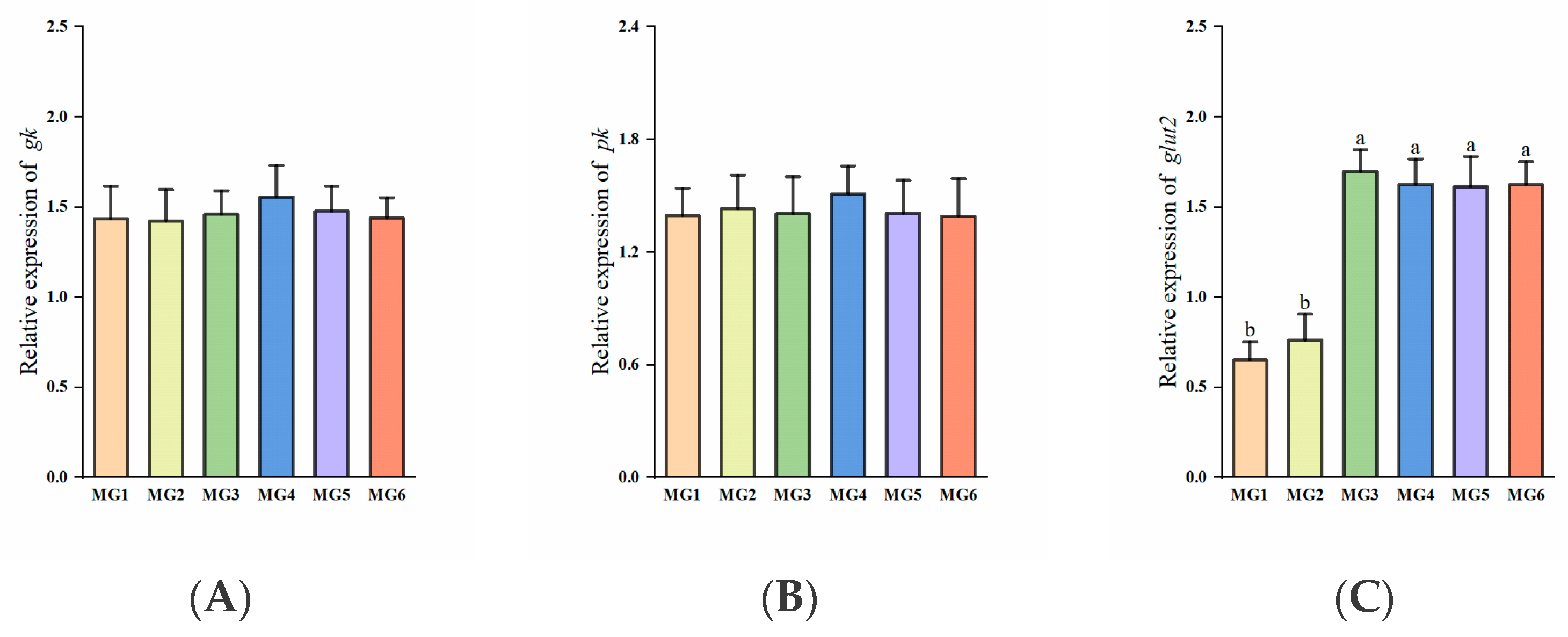

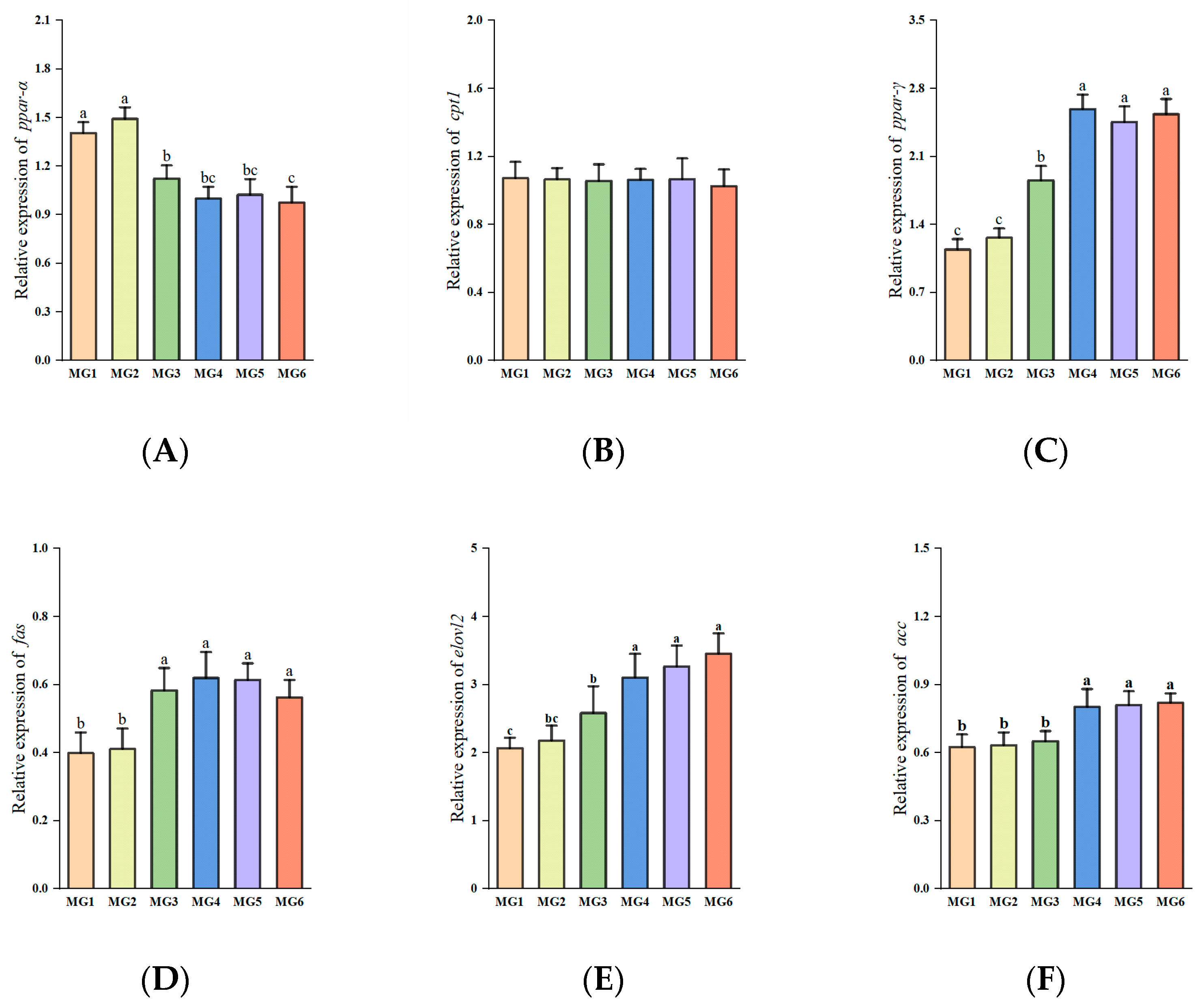
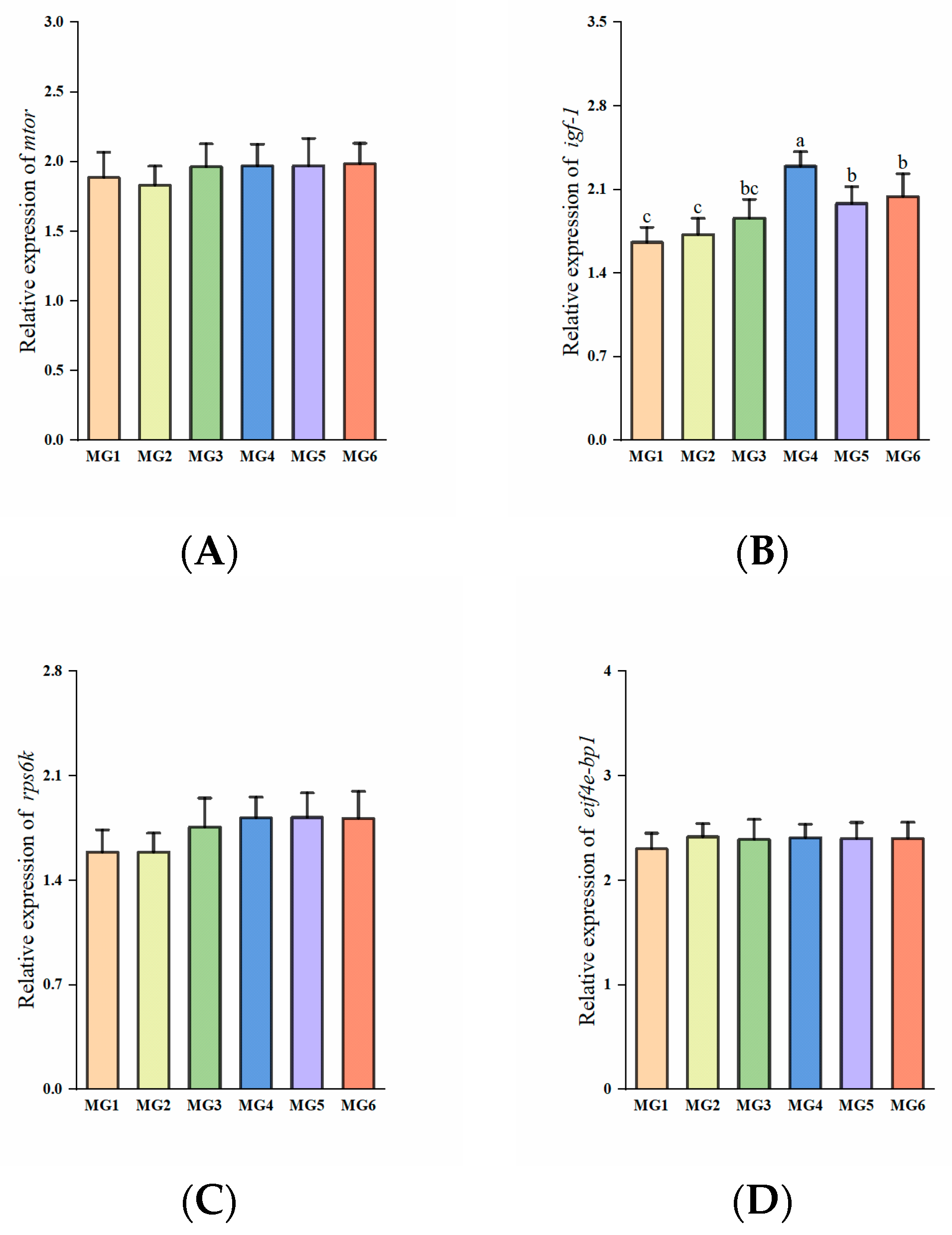
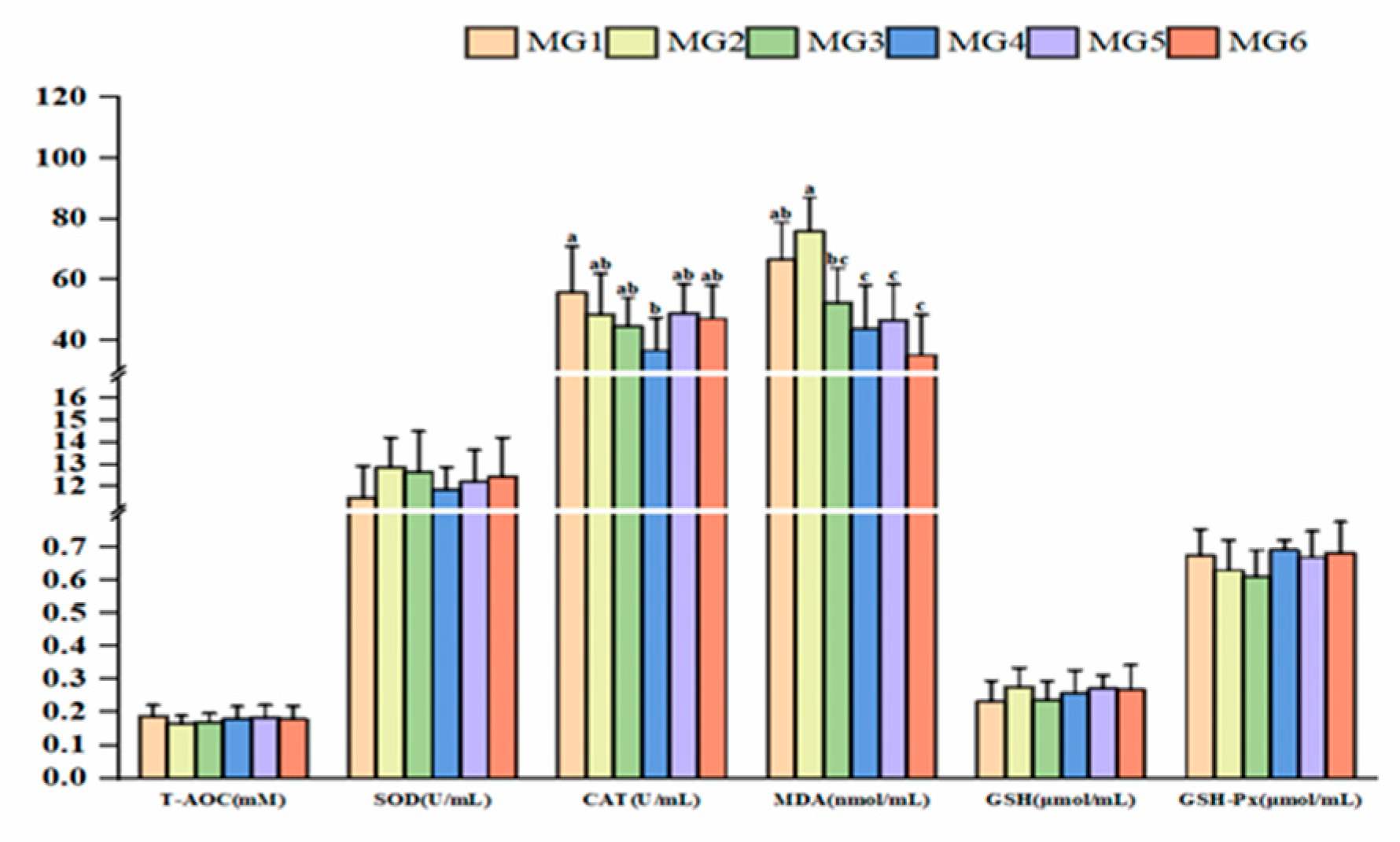


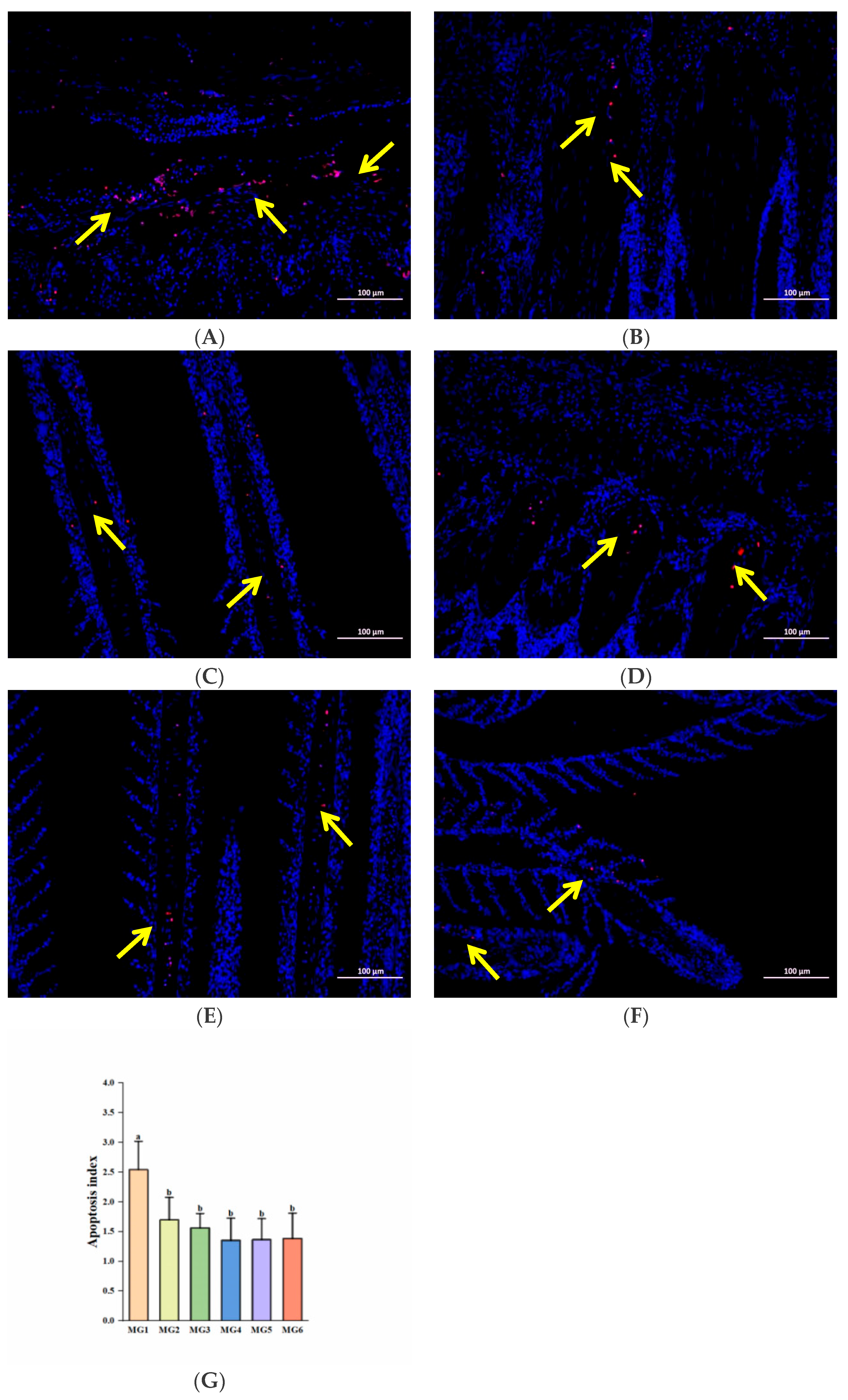
| Ingredients | Level (%) | Ingredients | Level (%) |
|---|---|---|---|
| Fish meal 1 | 15.00 | Choline chloride | 0.50 |
| Casein 2 | 31.20 | Vitamin premix 4 | 1.00 |
| Gelatine 3 | 7.80 | Mineral premix 5 | 1.00 |
| Wheat flour 1 | 16.00 | Monocalcium phosphate | 4.00 |
| Fish oil 1 | 4.50 | Microcrystalline cellulose | 14.40 |
| Soybean oil 1 | 4.50 | Vitamin C | 0.10 |
| Analyzed proximate composition (dry matter) | |||
| Crude protein (%) | 47.51 ± 0.70 | ||
| Crude lipid (%) | 10.55 ± 0.19 | ||
| Gross energy (KJ/g) | 15.38 ± 0.09 | ||
| Items | Methods | Assay Kits | Testing Equipment |
|---|---|---|---|
| Total protein (TP) | International Federation of Clinical Chemistry recommended | Mindray Medical International Ltd. (Shenzhen, China). | Mindray BS-400 automatic biochemical analyzer (Mindray Medical International Ltd., Shenzhen, China). |
| Glucose (GLU) | |||
| Total cholesterol (TC) | |||
| Triglyceride (TG) | |||
| Low-density lipoprotein cholesterol (LDL-C) | |||
| High-density lipoprotein cholesterol (HDL-C) | |||
| Superoxide dismutase (SOD) | WST-1 method | Jian Cheng Bioengineering Institute (Nanjing, China) | Spectrophotometer (Thermo Fisher Multiskan GO, Shanghai, China). |
| Glutathione (GSH) | Microplate method | ||
| Total antioxidant capacity (T-AOC) | ABTS method | ||
| Malondialdehyde (MDA) | TBA method | ||
| Catalase (CAT) | Ammonium molybdenum acid method | ||
| Glutathione peroxidase (GSH-Px) | Colorimetric method | ||
| Na+ | Colorimetric method | ||
| Na+/K+-ATPase | Colorimetric method | ||
| K+ | Microplate method | ||
| Cl- | Microplate method | ||
| Ca2+ | Microplate method | ||
| Moisture | Dry at 105 °C under atmospheric pressure until constant weight is achieved. | - | Electric blast drying oven (Shanghai Yiheng Scientific Instrument Co., Ltd., Shanghai, China) |
| Ash | Carbonize, then incinerate at 560 °C for 5 h. | XL-2A muffle furnace (Hangzhou, China) | |
| Real-time polymerase chain reaction (RT-PCR) | - | One-Step SYBR® PrimeScript™ PLUS RT-PCR Kit (Takara, Dalian, China) | CFX96 Real-Time PCR Detection System (Bio-Rad Laboratories, Shanghai, China) |
| Genes | Forward Primer (5′–3′) | Reverse Primer (5′–3′) | Source |
|---|---|---|---|
| Glyceraldehyde-3-phosphate dehydrogenase (gapdh) | ACTGTCACTCCTCCATCTT | CACGGTTGCTGTATCCAA | AZA04761.1 |
| Pyruvate kinase (pk) | CACGCAACACTGGCATCATC | TCGAAGCTCTCACATGCCTC | MT431526.1 |
| Glycerate kinase (gk) | CCCTTGTGGGCAGGAGAAAA | ACAACTGAGTCCTCCTTGCG | XP_023260296.1 |
| Phosphoenolpyruvate carboxykinase (pepck) | GGCAAAACCTGGAAGCAAGG | ATAATGGCGTCGATGGGGAC | MT431525.1 |
| Glucose 6-phosphatase (g6pase) | ACACAGCAGCCCTGTTCTAC | CCGTTCACACAGTACGGGAT | XM_038735542.1 |
| Glucose transporter 2 (glut2) | TCACCGTGTTTATTTATCTTCG | AGCTCCGTATCGTCTTTGG | XM_038728860 |
| Glucose 6-phosphate dehydrogenase (g6pdh) | AGTCCAGTCACTCCAACA | TCTCTGAATAACCACCACAA | CAG04059.1 |
| Elongation of very long Chain fatty acids protein 2 (elovl2) | GGACACAACAATACAAGATGG | GAACAGGTAGCACAGCAAT | Cluster-21914.20999 |
| Peroxisome proliferator-activated receptor-α (ppar-α) | AGGCTTCATCACCAGAGA | TCCGCAGCAGATAATAGTAG | MK614719.1 |
| Peroxisome proliferator-activated receptor-γ (ppar-γ) | GAGTTCTCAGTCAAGTTCAAC | AATGTAGCACCGTCTCCT | MK614721.1 |
| Acetyl-CoA carboxylase (acc) | TTACATCGCAGCCAACAG | CTCTCCACCTTCCTCTACA | XP_022609673.1 |
| Fatty acid synthase (fas) | AGTTGAAGGCTGCTGATG | GCTGTGGATGATGTTGGT | XP_028423094.1 |
| Carnitine O-palmitoyltransferase 1 (cpt1) | TTACCGTATGGCTATGACTG | GGCTCCGATAACACCTCT | XP_027141042.1 |
| Mechanistic target of rapamycin (mtor) | TTTGGAACCAAACCCCGTCA | ATCAGCTCACGGCAGTATCG | XM_038723321.1 |
| Ribosomal protein S6 (rps6) | TCCAGAGACTCGTGACACCT | AGCTTGGCATACTCTGAGGC | XM_038713349.1 |
| Eukaryotic translation initiation factor 4E-binding protein 1 (eif4e-bp1) | CCAGGATCATCTATGACCGAAAG | TGCAGCGATATTGTTGTTGTTC | XM_038703879.1 |
| Insulin-like growth factor-1 (igf-1) | CCTCTGCCTGTGTATAATCA | TGTCCGTCTTAGCCATCT | XM_038738328.1 |
| Nuclear factor-kappa B (nf-κb) | CCACTCAGGTGTTGGAGCTT | TCCAGAGCACGACACACTTC | XP_027136364.1 |
| Interleukin-10 (il-10) | CGGCACAGAAATCCCAGAGC | CAGCAGGCTCACAAAATAAACATCT | XM_038696252.1 |
| Transforming growth factor-β (tgf-β) | CACCAAGGAGATGCTGATT | CGTATGTTAGAGATGCTGAAG | XM_038693206.1 |
| Interferon-γ (ifn-γ) | GAGCAAAGCATTGTGGGAGC | AGATGAGTTTTGGCCCTCCG | XM_038707474.1 |
| Caspase-3 (casp3) | GAGGCGATGGACAAGAGTCA | CACAGACGAATGAAGCGTGG | XM_038713063.1 |
| Caspase-8 (casp8) | GAGACAGACAGCAGACAACCA | TTCCATTTCAGCAAACACATC | XM_038726463.1 |
| Bcl-2 associated X protein (bax) | ACTTTGGATTACCTGCGGGA | TGCCAGAAATCAGGAGCAGA | XM_038704178.1 |
| B-cell lymphoma-2 (bcl-2) | TGTGGGGCTACTTTTTGGCA | TTCGACTGCCACCCCAATAC | PRJNA725023 [33] |
| Apoptosis signal regulating kinase 1 (ask1) | CAACTACGCCTTCATCCCGT | GGTCCCAACAGCATCTCGAA | PRJNA725023 [33] |
| C-Jun N-terminal kinase 2 (jnk2) | GTCTTCTCCCTTCACCGCTC | CGTGACAGCCGGTTTTCCTA | PRJNA725023 [33] |
| Interleukin-8 (il-8) | GAGGGTACATGTCTGGGGGA | CCTTGAAGGTTTGTTCTTCATCGT | XM_038713529.1 |
| Tumor necrosis factor-α (tnf-α) | CTTCGTCTACAGCCAGGCATCG | TTTGGCACACCGACCTCACC | XM_038710731.1 |
| Diets | IBW (g) | FBW (g) | WGR (%) | SGR (%/d) | FCR |
|---|---|---|---|---|---|
| MG1 | 2.27 ± 0.02 | 15.27 ± 0.56 c | 569.04 ± 31.81 b | 3.02 ± 0.08 b | 1.50 ± 0.05 a |
| MG2 | 2.28 ± 0.01 | 15.55 ± 0.27 bc | 582.85 ± 9.17 b | 3.05 ± 0.02 b | 1.48 ± 0.03 ab |
| MG3 | 2.28 ± 0.02 | 16.60 ± 0.70 abc | 629.45 ± 36.81 ab | 3.15 ± 0.08 ab | 1.41 ± 0.03 bc |
| MG4 | 2.27 ± 0.01 | 17.41 ± 0.26 a | 667.59 ± 14.20 a | 3.23 ± 0.03 a | 1.37 ± 0.03 c |
| MG5 | 2.26 ± 0.01 | 16.72 ± 0.23 ab | 640.33 ± 11.46 ab | 3.18 ± 0.02 ab | 1.41 ± 0.02 abc |
| MG6 | 2.27 ± 0.03 | 16.05 ± 0.53 bc | 608.78 ± 28.26 ab | 3.11 ± 0.06 ab | 1.41 ± 0.01 bc |
| Diets | Moisture (%) | Crude Protein (%) | Crude Lipid (%) | Ash (%) |
|---|---|---|---|---|
| MG1 | 70.97 ± 0.23 | 16.17 ± 0.08 | 9.23 ± 0.08 b | 3.43 ± 0.11 |
| MG2 | 70.79 ± 1.29 | 16.20 ± 0.06 | 9.72 ± 0.15 ab | 3.28 ± 0.06 |
| MG3 | 69.69 ± 0.80 | 16.16 ± 0.14 | 9.92 ± 0.60 ab | 3.23 ± 0.15 |
| MG4 | 70.09 ± 0.70 | 16.36 ± 0.23 | 10.12 ± 0.54 ab | 3.30 ± 0.13 |
| MG5 | 69.77 ± 0.55 | 16.13 ± 0.15 | 10.28 ± 0.33 ab | 3.21 ± 0.11 |
| MG6 | 69.57 ± 1.71 | 16.36 ± 0.03 | 10.32 ± 0.35 a | 3.19 ± 0.12 |
| Diets | GLU (mmol/L) | LDL-C (mmol/L) | HDL-C (mmol/L) | TP (g/L) | TG (mmol/L) | TC (mmol/L) |
|---|---|---|---|---|---|---|
| MG1 | 16.14 ± 1.94 a | 2.63 ± 0.45 a | 2.23 ± 0.28 b | 26.14 ± 2.82 | 11.76 ± 1.75 a | 4.63 ± 0.78 |
| MG2 | 14.62 ± 2.93 ab | 1.72 ± 0.42 b | 3.37 ± 0.59 a | 28.48 ± 5.37 | 5.17 ± 1.49 b | 4.45 ± 0.66 |
| MG3 | 15.72 ± 2.11 a | 1.97 ± 0.25 b | 3.15 ± 0.61 a | 27.55 ± 3.58 | 5.78 ± 0.84 b | 4.78 ± 0.91 |
| MG4 | 12.11 ± 1.17 b | 1.75 ± 0.44 b | 3.29 ± 0.45 a | 30.70 ± 2.12 | 5.31 ± 0.82 b | 5.13 ± 1.07 |
| MG5 | 13.44 ± 1.46 ab | 1.81 ± 0.43 b | 3.41 ± 0.46 a | 30.13 ± 3.83 | 4.98 ± 1.44 b | 4.40 ± 0.47 |
| MG6 | 14.89 ± 3.09 ab | 2.00 ± 0.31 b | 3.28 ± 0.59 a | 29.25 ± 3.21 | 5.37 ± 1.22 b | 4.53 ± 0.44 |
| Diets | Na+ (mmol/L) | K+ (mmol/L) | Cl− (mmol/L) | Ca2+ (mmol/L) | Na+/K+-ATPase (U/mgprot) |
|---|---|---|---|---|---|
| MG1 | 134.63 ± 10.29 | 2.94 ± 0.40 a | 144.33 ± 10.26 b | 0.69 ± 0.08 b | 0.22 ± 0.04 d |
| MG2 | 137.90 ± 9.28 | 2.93 ± 0.22 ab | 157.55 ± 15.78 ab | 1.07 ± 0.16 a | 0.48 ± 0.08 c |
| MG3 | 147.39 ± 8.27 | 2.54 ± 0.42 ab | 157.41 ± 7.64 ab | 1.00 ± 0.18 a | 0.73 ± 0.15 b |
| MG4 | 147.35 ± 6.90 | 2.43 ± 0.47 b | 161.92 ± 7.37 a | 1.10 ± 0.21 a | 1.81 ± 0.15 a |
| MG5 | 143.21 ± 11.02 | 2.53 ± 0.18 ab | 158.49 ± 10.56 ab | 1.08 ± 0.26 a | 0.75 ± 0.10 b |
| MG6 | 133.37 ± 11.68 | 2.63 ± 0.28 ab | 147.54 ± 14.54 ab | 1.02 ± 0.15 a | 0.16 ± 0.04 d |
Disclaimer/Publisher’s Note: The statements, opinions and data contained in all publications are solely those of the individual author(s) and contributor(s) and not of MDPI and/or the editor(s). MDPI and/or the editor(s) disclaim responsibility for any injury to people or property resulting from any ideas, methods, instructions or products referred to in the content. |
© 2025 by the authors. Licensee MDPI, Basel, Switzerland. This article is an open access article distributed under the terms and conditions of the Creative Commons Attribution (CC BY) license (https://creativecommons.org/licenses/by/4.0/).
Share and Cite
Qin, J.; Huang, D.; Liang, H.; Chen, X.; Gu, J.; Ren, M.; Zhang, L. Magnesium Promotes Growth–Metabolism Balance in Juvenile Largemouth Bass (Micropterus salmoides) and Modulates Antioxidant–Inflammatory–Apoptotic Responses Under Heat Stress. Antioxidants 2025, 14, 1394. https://doi.org/10.3390/antiox14121394
Qin J, Huang D, Liang H, Chen X, Gu J, Ren M, Zhang L. Magnesium Promotes Growth–Metabolism Balance in Juvenile Largemouth Bass (Micropterus salmoides) and Modulates Antioxidant–Inflammatory–Apoptotic Responses Under Heat Stress. Antioxidants. 2025; 14(12):1394. https://doi.org/10.3390/antiox14121394
Chicago/Turabian StyleQin, Junjie, Dongyu Huang, Hualiang Liang, Xiaoru Chen, Jiaze Gu, Mingchun Ren, and Lu Zhang. 2025. "Magnesium Promotes Growth–Metabolism Balance in Juvenile Largemouth Bass (Micropterus salmoides) and Modulates Antioxidant–Inflammatory–Apoptotic Responses Under Heat Stress" Antioxidants 14, no. 12: 1394. https://doi.org/10.3390/antiox14121394
APA StyleQin, J., Huang, D., Liang, H., Chen, X., Gu, J., Ren, M., & Zhang, L. (2025). Magnesium Promotes Growth–Metabolism Balance in Juvenile Largemouth Bass (Micropterus salmoides) and Modulates Antioxidant–Inflammatory–Apoptotic Responses Under Heat Stress. Antioxidants, 14(12), 1394. https://doi.org/10.3390/antiox14121394







